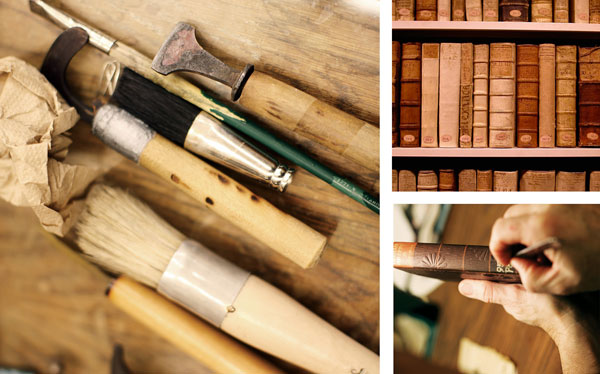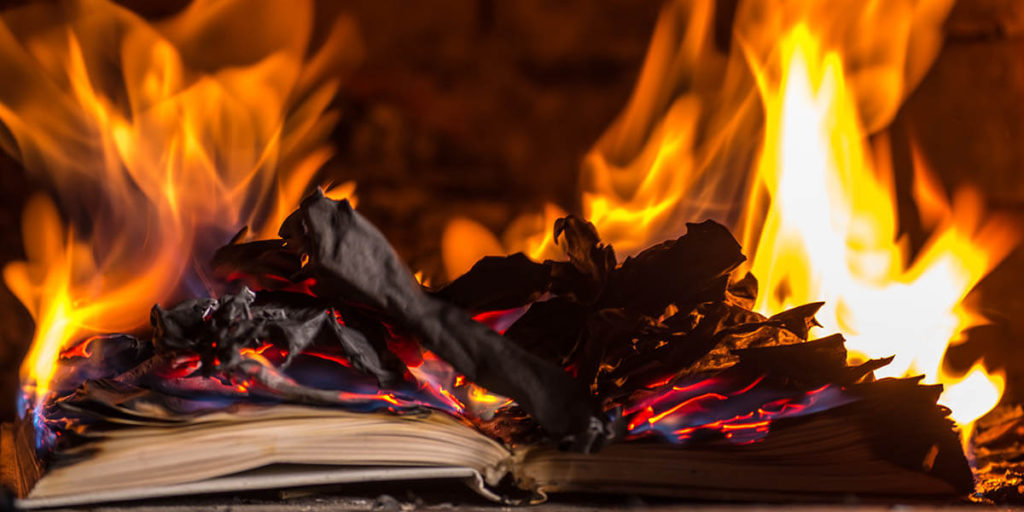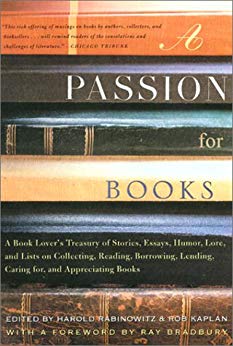
Us collectors love our treasured books, we want to take care of them and know they will stay in good condition under our care.
I wanted to share an excerpt from a book that covers the biggest enemy of books; Fire, Water, Gas and Heat, Light, Duct and Neglect, Ignorance, and The Bookworm (and other Vernon).
The following essay is one chapter featured in a book called A Passion for Books, which is a collection of sixty classic and contemporary essays, stories, lists, poems, quotations, and cartoons on the joys of reading, appreciating, and collecting books.
How to Care for Books
by Estelle Ellis and Caroline Seebohm
In 1880 William Blades wrote his comprehensive The Enemies of Books. This classic, though filled with stern admonitions, is as relevant today as it was a century ago. Blade’s work speaks to those who are building or restoring a library, starting a special collection, or those simply interested in preserving the books they read in their youth for their children and grandchildren. Just as people often think to create a protected environment for painting or photographs, so should they for their books.
1 Fire
There are many forces of Nature which tend to injure books; but among them, all not one has been half as destructive as fire. -W.B

Blades calculates that not only is fire the most destructive of all enemies of books, but that only one-thousandth of the books that once existed still exist, thanks to what he calls the “fire-king.”
Good housekeeping, according to the National Fire Protection Association, is the number one way to prevent a fire. As in a forest deprived of rain, overly dry conditions are conducive to fire. Climate control through central air-conditioning can guard against the drying and dust-promoting nature of heat. Some collectors use fireproof walls or containers and choose nonflammable or fire retardant material for library curtains.
Smoking is as bad for books as it is for people. Not only does it increase the chances of fire because of a dropped ash or fallen match, but smoke can work its way into the pages of books and leave a smell behind. If you smoke, or have guests who do, be especially alert when you’re in the library.
After studying the effects of a serious fire that caused considerable damage due to heat, Don Etherington, former conservator of the Harry Ransom Humanities Research Center, found that books that had been oiled resisted heat better than those that had not been treated. The smaller the book, the greater the damage. Leather bindings and labels, including those in glass-fronted cases, frizzled or looked bubbled, particularly those on upper shelves where heat was most intense. Rapid decrease in humidity may be the reason for this. Leather bindings should be put on lower shelves even in glass-fronted cases where they are, in general, better protected. Polyester dust jackets are also a good book saver.
If fire or smoke does damage to your books, there are materials that can help you repair them. Jane Greenfield, author of The Care of Books, finds that Pink Pearl erasers work better than any other material for removing scorch marks. Damp sponges work best on smooth cloth but do not work well on paper. Extra-fine steel wool will take the soot off leather bindings and leave them intact. However, she says, “Beware of chemical sponges which leave residual film. To get rid of any lingering smell after a fire, thoroughly air books out on a slightly breezy day. Stand books, fanned out, on a table in the shade, but do not leave them overnight. Some damage restoration firms can also provide equipment to dissipate residual odor.” To find such a firm in your area, check the Yellow Pages under “Fire and Water Damage Restoration.”
2 Water
Next to Fire we must rank Water in its two forms, liquid and vapour, as the greatest destroyer of books. -W.B
Aside from flooding through natural disaster or otherwise, water vapor or general dampness can lead to mold and disfigured books. As Blades describes it, “outside it fosters the growth of a white mould or fungus which vegetates upon the edges of the leaves, upon the sides, and in the joints of the binding.”
Doris Hamburg, in Caring for your Collections, notes the warning signs of dampness and methods of treatment. A musty smell and the appearance of fuzzy spores are the tip-offs. If mold develops, as it is prone to do in seaside houses or in basements, remove the affected books and place them in a dry area. Then, on a sunny day, take the books outside and lightly brush the mold with a soft camel-hair brush to remove the spores. Dabbing, but not rubbing, with a kneaded eraser will show whether the material is too delicate to be brushed. If so, or if in doubt, bring the books to a professional conservator.
Mold develops because of poor air circulation and too much humidity. So if your keeping your books in glass-fronted bookcases, make sure that you open them periodically to provide essential ventilation. Mold grows at 70 degrees Fahrenheit and 65 percent relative humidity in stagnant air. It can be prevented or controlled by maintaining a library temperature below 70 degrees Fahrenheit and by allowing relative humidity to climb no higher than 60 percent, preferably keeping it closer to 50 percent. Air-conditioning and fans can be used for climate control. Dehumidifiers help through the warmer seasons. Humidifiers should be used in the winter when a well heated library also means too little humidity, which can dry books and increase the risk of fire.
If you live in a house that tends to flood, keep your bookshelves at least twelve inches from the floor. Collector Timothy Mawson recalls the morning he came into his New York shop after such in-house flooding. “A water pipe broke in the men’s room above and totally flooded everything. We used waxed paper between the pages of the books so they would not stick together and worked at it for nearly forty-eight hours, saving an enormous number of books.”
If your books get wet, those that are not absolutely saturated can be dried with a fan. Stand the books on several layers of paper towels or unprinted newspaper (available at art supply stores) and let one or two fans blow on them if possible; use a piece of Styrofoam under the opened books for support. Books can also be dried by placing paper towels or unprinted newspaper within the book one every fifty pages or so. (Newspaper is a good absorber, but because of its acidic content it should not be left inside a book for too long.) The towels and/or newspaper should be changed often–a time-consuming operation. When books are almost dry (slightly cool to the cheek), close them and finish the drying under light weights. Softcover books can be dried this way or hung on a clothesline. (If your collection is seriously damaged by water, remind your insurance company that the longer wet books sit and mold forms, the higher the cost of restoration; this may hasten an appraisal.)
For books with coated paper, such as most illustrated books, freeze or vacuum drying is recommended. (This paper tends to stick together when wet and then dried by the usual method.) Wrap your books in freezer paper and pack them tightly in plastic milk crates. While taking books to a rapid-freezing facility is best, a home freezer can be used. After the books are frozen, they should be kept at -15 to 20 degrees Fahrenheit until a vacuum-drying facility can take them to be dried. (in vacuum drying, water goes straight from ice to vapor.)
Very few facilities offer these techniques of freezing and vacuum drying. For addresses to those in your area, contact WEL T’O Associates, P.O. Drawer 40, 21750 Main Street, Unit 27, Matteson, IL 60443; (312) 747-6660. Also check the Yellow Pages under “Fire and Water Damage Restoration.”
3 Gas and Heat
Treat books, as you should your own children, who are sure to sicken if confined in an atmosphere which is impure, too hot, too cold, too damp, or too dry. -W.B
Blades, writing about the twin dangers if gas and heat, had witnessed the damaging effect his gas lamps had on books stored on upper shelves. The sulphur in the gas fumes had turned them into the consistency “of scotch snuff.” Today, air-conditioning and protective cases are the best guards against chemical threats.
Though chemicals such as sulphur dioxide and other air pollutants are a potent danger to books, heat alone can damage books by drying out and destroying their bindings. Heat, Jane Greenfield says, increases the deconstructive power of acid that may be lurking within a book’s paper or ink, and causes a lowering of relative humidity.
Designer Jack Lenor Larsen recalls visiting an elegant library years ago and being told that four maids would apply Vaseline to all the leather bindings twice a year to prevent them from drying out. For those without four maids or a lot of free time, the best preventative to heat damage is to maintain a library temperature of between 60 and 70 degrees Fahrenheit, preferably at the lower and of the scale, and to keep books away from the radiator and other heat sources.
4 Light
The electric light has been in use in the Reading Room of the British Museum, and is a great boon to the readers. However, you must choose particular positions if you want to work happily. There is a great objection too in the humming fizz which accompanies it … and there is still greater objection when small pieces of hot chalk fall on your head. – W.B
Though Blades foresaw the downside of electric lighting for the reader, he did not foresee its particular dangers to the books themselves. “Light,” Dorris Hamburg writes, “causes changes in the paper structure itself as well as leading to bleaching, fading, darkening, and/or embrittlement.” The ultraviolet rays in fluorescent lights can be damaging, explains Elaine Haas, president of TALAS, a professional resource center for libraries. If you have very valuable books, she suggests you slip special ultraviolet absorbent material over the fluorescent tubes.
But in addition to artificial light sources, sunlight can be equally or more damaging. Even indirect sunlight can lead to fading. An unpopular but simple way to protect your collection is to draw the blinds in your library. Food book collector Richmond Ellis uses window shades on the bookshelves themselves.
5 Dust and Neglect
Dust upon Books to any extent points to Neglect, and Neglect means more or less slow Decay. -W.B
For those who hate to dust, there are storage options to avoid the problem. Jack Lenor Larsen adopted Japanese design practices and found that “if fabrics are hung up from the ceiling to cover the books, I don’t have to look at a lot of stuff all the time. It also reduces dust and therefore cleaning and breakage.” Window shades can also protect books from dust and other pollutants. Make sure any material you use is acid-free. Protective book boxes can preserve rare books from dust or pollution.

There is no formula for how often a library must be dusted; it depends on the environment. Anthony Trollope dusted his library twice a year. Frequent vacuuming and/or sweeping will reduce dust buildup. A feather duster is the classic implement for removing dust, but a vacuum cleaner is better, A portable mini-vac, or Dustbuster, though less powerful, may be easier to use in the small spaces between books. Barbara Kirschenblatt-Gimblett uses something in between–a Service Vacuum Clea she ordered through Contact East, Inc., North Andover, Massachusetts. Designed for cleaning delicate office equipment like computers, disk drives, and printers, this vacuum is portable and relatively light, weighing a total of nine pounds.
Regardless of the method you choose, Jane Greenfield recommends you begin by cleaning the top edge of the book. Dust and vacuum away from the spine and hold the book tightly so the dust does not work its way down into the pages. You can use saddle soap on leather bindings to remove dust, dirt, and grime, but not on gold tooling or turn-ins (leather-bound books whose binding extends within the inside edges of the covers and spine). Any moisture can cause blackening and cracking of deteriorating leather, so clean them only if you have to. If you decide to clean your leather bindings, form a lather with the saddle soap and rub the lather into the leather. Wipe off the excess with a clean, damp sponge, drying the binding with a lint-free cloth. Let the book dry completely before putting it back. For cloth bindings, you can use Bookleen Gel, available from library resources. For rare paper bindings, expert help may be required, such as described in Anne F. Clapp’s book, Curatorial Care of Works of Art on Paper: Basic Procedures for Paper Preservation.
6 Ignorance
Ten years ago, when turning out an old closet in the Mazarine Library, of which I am librarian, I discovered at the bottom, under a lot of old rags, a large volume. It had no cover nor title-page, and had been used to light the fires of librarians. -W.B
Even the best-educated bibliophiles, like author and journalist Roger Rosenblatt, are torn between their respect for books and their desire to enjoy them to their fullest, for instance, by engaging with the text through scrawled commentary. “It’s shameful to admit: I deface books all the time,” he says, referring to his penciled scribbles. “And I enjoy seeing the scribbles of others. There is a communicative and emotional value in a record of another human being’s thoughts and feelings left for future readers to happen upon. Of course, though this harms a book, if the scribbler happens to have been Henry James or James Joyce, the book becomes much more valuable.”
Books can also be damaged by people’s well-meaning efforts to repair them, particularly by using nonrestoration-quality material such as transparent or duct tape to repair torn pages or bindings. Bookbinders have to use Unseal Adhesive Releasing Solvent to remove such tape from books. If you do not wish to take a damages book to a professional restorer, binders Wilton Wiggins and Douglas Lee advise you to wrap the book in acid-free paper and tie it up with library tape, a flat cotton string that can be used to hold the book together if the spine or binding is loose. There are also special tapes available in a first-aid kit from TALAS in New York and other resources.
7 The Bookworm (and Other Vermin)
There is a sort of busy worm
That will the fairest books deform,
By gnawing holes throughout them.
Alike, through every leaf they go,
Yet of its merit nought they know,
Nor care they aught about them.
Their tasteless tooth will tear and taint
The Poet, Patriot, Sage, or Saint,
Nor sparing wit nor learning.
Now, if you’d know the reason why,
The best of reasons I’ll supply:
‘Tis bread to the poor vermin.
–J. Doraston (Quoted by William Blades)
Worms, beetles, and creepy-crawlies of all kinds can chomp through your precious volumes and turn them into fodder–and birthing places for larvae. “If,” Jane Greenfield says, “you have termites in your bookshelves, or if you are stacking books from suspect areas, like barns, cellars and attics, you should freeze the collection before placing it in your library.” She reports that a simple at-home method was developed by Yale University biology professor Charles Remington: Make sure the books are completely dry, thereby preventing the formation of ice crystals. Seal your books or wrap them well in plastic bags, preferably made of polyethylene, and freeze them at 6 degrees Fahrenheit in a domestic freezer. (At Yale, books are frozen at -20 degree Fahrenheit for seventy-two hours.) This will kill all beetles and insects at all stages of development.
Here is an image of A Passion for Books, with the selected Chapter, How to Care for Books, by Estelle Ellis and Caroline Seebohm which I pulled excerpts from for this article. It can be purchased on Amazon or by clicking on the image below:






Nowadays, books are considered collectibles. In our digital world, I hardly see people collecting books anymore.
But for me, I still have a bookshelf (not too big) where I put my all-time favorite books. Even my favorite books in my college years ( I have two of them) are sitting on those shelves.
I am in the middle of cleaning and clearing items of my house, and one of them is the bookshelf. I am so glad to have read your article. I wanted to keep those hard-covered special books and now I know how I can take care of them.
Thank you for your article.
Hello Henna (* ̄▽ ̄*)ノ”
You are very welcome. The book I made mention of has various authors who deserve credit for the resource information I pulled for the great information I pulled. I’m glad to hear you a few more tips to help preserve books that are in your collection, especially your favourites! (‘∀’●)♡
I had no idea that dust and neglect was a thing either until I looked into it! It was nice to hear from you!
Wow, this is interesting. I had several books ruined years ago by water and mold, when some pipes in the apartment upstairs busted and flooded my master bedroom closet. I had to throw a couple of them away, because they were that badly damaged. The ones I was able to keep weren’t in the best shape, but were at least salvageable. On another note, I had no idea that light was that damaging to paper! Wow. I will definitely keep this in mind. It’s hard to strike a proper balance between having enough light to read and not so much of it that you ruin your books.
I had no idea how much in-depth one can get about caring for books. It makes sense because of the sensitivity of books and how susceptible they are to being damaged in so many different ways. This will be extremely valuable information for the book-lovers and collectors of the world. When you mentioned how cigarette smoke can seep into pages if reminded me of what I came across in an antique store one day. I love checking out old books. I opened up one that was published in the late 1800s and this amazing scent of sweet-smelling tobacco smoke came wafting out. At that moment I imagined a gentleman over a century ago in housecoat and slippers sitting in front of the fireplace smoking his pipe and reading the book. The smoke had eaten its way right into the pages.
“To hold a hard covered book in one’s hands and sniff the Ages in it is a wonder of delight!” There was a lady who came to my place to buy a book from me and she smelled the book and that is what she said. I wrote it down right away because it was a perfect way to describe how I feel about certain old books that I have. I asked her where she got that quote from and her answer was. “God put it in my head one day”. Your story about the memory you had opening up that book from the 1800 century made that quote come to mind.
It was nice to have you back visiting Ash Tree Books today Ray!
Hey Ashley,
This is really an unique and useful article. I love reading books as books are our best friends and we acquire knowledge from them. But as I have a big collection of several books it’s difficult for me to take care of them. Even sometimes many of my books get teared as I don’t get enough chance to take care of them. You have given some really good ideas to take care of our valuable books. Moreover I did not know that seddle soups can be si useful to remove dust and dirt from our books. But now I know that and I will surely try that. Moreover I will keep all of your tips in my mind.
Thank you for writing this helpful article.
Great post! This is a very unique and helpful topic for all book lovers, one that is not given enough thought. Books are very important to maintain and this post provides solid insight, especially for those collectors of rare books. I like how you referenced how to care for your books IF something were to happen, such as using Pink Pearl, vacuum drying, window shade usage, vacuums, duct tape, sealants, etc. Very informative post, well done!
This is a really in-depth analysis of how one should care for treasured books. I have a few older books, mainly Bibles, that are it will be handed down to my family. I knew of most of the elements you discussed, but didn’t realize light was also a culprit. I figured the sun would do damage, but not artificial light. It looks like I will have to make some adjustments to my personal library.
I will be passing this information to family and friends that also have a small collection so they will be able to pass these treasures down to loved ones in the future. Thank you for bringing this to my attention.